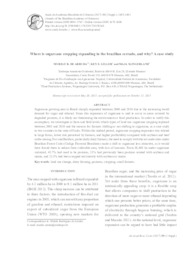Where is sugarcane cropping expanding in the Brazilian cerrado, and why? A case study.
Where is sugarcane cropping expanding in the Brazilian cerrado, and why? A case study.
Authorship: ARRUDA, M. R. de; GILLER, K. E.; SLINGERLAND, M.
Summary: Sugarcane growing area in Brazil sharply expanded between 2000 and 2010 due to the increasing world demand for sugar and ethanol. Since this expansion of sugarcane is said to occur in areas covered by degraded pastures, it is likely not threatening the environment or food production. In order to verify this assumption, we investigate at farm and field levels which types of land use sugarcane cropping replaced between 2005 and 2010 and the reasons for farmers shifting or not shifting to sugarcane, as a case study in two counties in the state of Goiás. Within the studied period, sugarcane cropping expansion was related to large farms, lower risk perceived by farmers, and higher profitability compared with soybean and beef cattle-raising. For smallholders, particularly dairy farmers, the need to comply with the set-aside rules under Brazilian Forest Code (Código Florestal Brasileiro) made a shift to sugarcane less attractive, as it would have forced them to reduce farm cultivable area, with loss of incomes. From 30,408 ha under sugarcane surveyed, 45.7% had used to be pastures, 31% had previously been pastures rotated with soybean and maize, and 23.3% had been cropped exclusively with soybean or maize.
Publication year: 2017
Types of publication: Journal article
Unit: Embrapa Western Amazon
Keywords: Cana-de-açúcar, Cropping, Small farmers
Observation
Some of Embrapa's publications are published as ePub files. To read them, use or download one of the following free software options to your computer or mobile device. Android: Google Play Books; IOS: iBooks; Windows and Linux: Calibre.
Access other publications
Access the Agricultural Research Database (BDPA) to consult Embrapa's full library collection and records.
Visit Embrapa Bookstore to purchase books and other publications sold by Embrapa.

